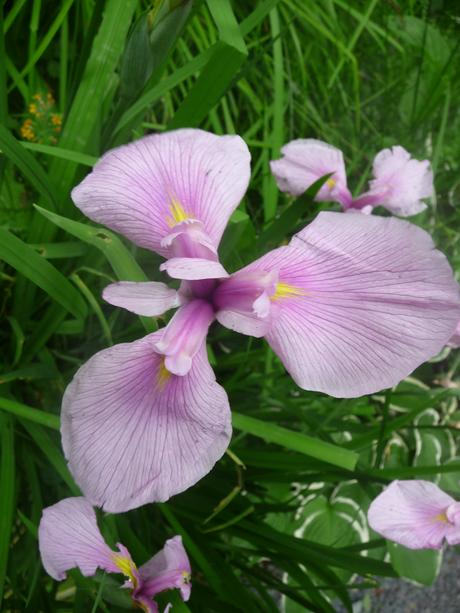 still asleep with just a hint of crinkled green leaves in suspended animation, yesterday was the perfect time to get in there. The first job was to remove the old rhubarb like leaves from the Brazilian giant, revealing the handsome, furry russet trunks that remind me of terracotta warriors. There are two springs running through the area which is very wet in places and never ever dries out! In late spring the whole area is a picture with Candelabra Primulas in deep orange, rich purple and pink shades, up to their necks in soggy clay soil and perfectly happy. At the moment, there is neither sight nor sign of them still in their watery winter beds!
still asleep with just a hint of crinkled green leaves in suspended animation, yesterday was the perfect time to get in there. The first job was to remove the old rhubarb like leaves from the Brazilian giant, revealing the handsome, furry russet trunks that remind me of terracotta warriors. There are two springs running through the area which is very wet in places and never ever dries out! In late spring the whole area is a picture with Candelabra Primulas in deep orange, rich purple and pink shades, up to their necks in soggy clay soil and perfectly happy. At the moment, there is neither sight nor sign of them still in their watery winter beds!
Iris too are planted there – the water loving Siberian types in deep blue and wine red shades, along with the later flowering Japanese Iris (ensata) ‘Rose Queen’ a stunning shade of clear pink with delicate yellow veining on the falls (lower petals). But for now, no real sign of these either except for the rotten brown leaves from last year which have been cut off after protecting the crowns of the plants through the winter months. Tiny green shoots are underneath and will soon begin to grow away to handsome sword shaped leaves that will frame the flowers at midsummer – fleeting but beautiful and replaced by striking seed capsules for later interest. As these flower, so to do the Himalayan Cowslips (Primula florindae), their sweetly scented blooms hanging in clusters atop tall stems. These seed freely in this area – on the gravel paths and in the watery parts as well and I wouldn’t be without them. Walking past them in the morning on a still day and breathing in the sweet perfume is a highlight of early summer for me!
Everything in this shady, wet area is underground for now and after a tidy up of all the old leaves and a day weeding the Creeping Buttercup and Water Mint it looked decidedly empty and desperately lacking in any winter interest at all.
Luckily there are plenty of shrubs which will relish the wet shady conditions and a few that will be happy on the shady bank above this area.
Dog Woods are the first to come to mind – they don’t care if they sit in water and will reward with their striking red bark through the winter months. Cornus alba ‘Siberica’ is one of my favourites with bright sealing wax red bark and rich autumn leaf tints of deep plum purple – just the thing to plant behind a white and green variegated evergreen grass. Viburnum opulus has the common name of ‘Bog Elder’ and again will grow in heavy soil. The jagged leaves turn rich shades of red and plum in autumn and the plant has flat clusters of white flowers in early summer followed by red berries for the birds.
Given that the Gunnera will shade a lot of this area out with its gigantic umbrella like leaves, we don’t have room for too many shrubs in the boggy ground but there is room on the bank running down to the site for shrubs that like moist soil and shade from the trees above.
The bubble gum smell of Philadelphus has to be one of the best summer scents and these hardy shrubs are perfectly happy in part shade and moist soil. As well as a gift for our noses, bees adore the flowers so one of these is essential and will fill the gap between the spring and autumn flowers of the evergreen Mexican Orange Blossom (Choisya ternata) another sweetly scented shrub that is as happy in shade as full sun. There is already a beautiful golden leaved Weigela planted nearby which has stunning burnt red flowers in early summer and is another magnet for bees so to complete the picture and add another shade loving shrub to the collection we have opted for an ornamental Elderberry, Sambucus racemosa ‘Sutherland Gold’ with filigree leaves of golden yellow. Kept hard pruned, it should make a pleasing mound in this area, not unlike a Japanese Maple but more able to stand the ripping northerly wind that hits this area of the garden at times. Who knows? We may even get clusters of white flowers and red berries on it once the plant is established.
Gardens are never finished – they are always evolving and we have taken a big step with this area. I can’t wait to find out how it looks in a few months time!
